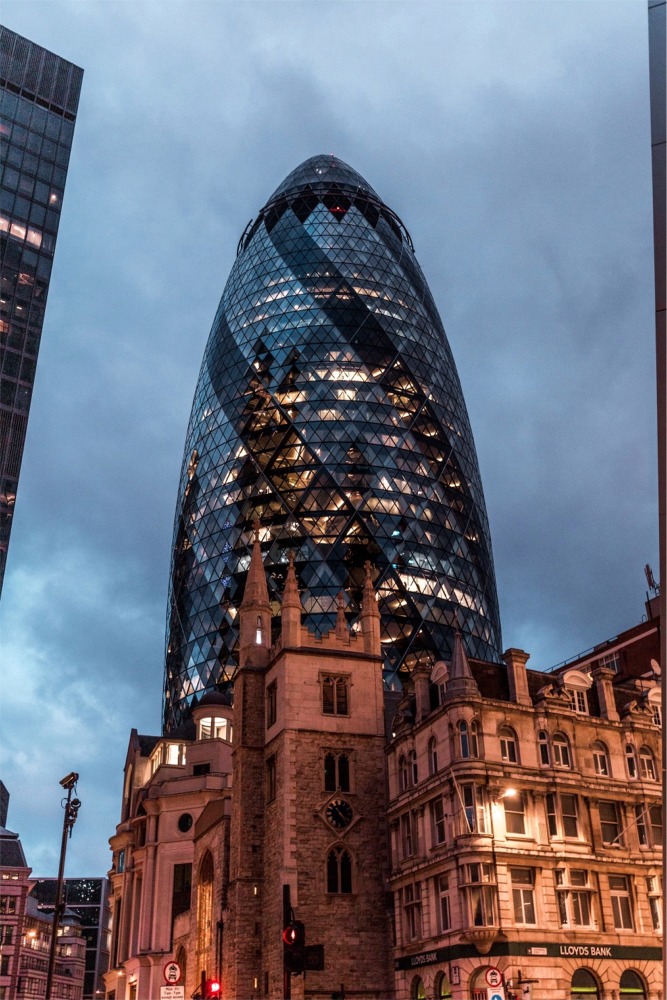30 St. Mary Axe
aka The Gherkin
Home > Photos from England > London Gallery 2 > 30 St. Mary Axe aka The Gherkin

30 St Mary Axe, also known as "The Gherkin," is a distinctive skyscraper located in the heart of the financial district of London, UK. The building is famous for its unique, curved shape, which resembles that of a pickled gherkin.
The Gherkin was designed by renowned architect Sir Norman Foster and was completed in 2003. The building stands 180 meters tall and has 41 floors. It is primarily used as office space, and its tenants include a range of businesses and financial institutions.
One of the most notable features of The Gherkin is its energy-efficient design. The building uses a range of sustainable technologies, such as natural ventilation, to reduce its carbon footprint. It also has a unique spiraling shape, which helps to reduce wind resistance and minimize the need for structural support.
The building also includes several amenities for its tenants, such as a fitness center, a restaurant, and a bar. The top floor of the building is used as an event space and offers panoramic views of London's skyline.
The Gherkin has become an iconic landmark of London and is recognized around the world as a symbol of modern architecture. It is a popular destination for tourists, and visitors can take a guided tour of the building to learn more about its history and design.
30 St Mary Axe
St Mary Axe was a medieval parish in the City of London whose name survives as that of the street which formerly occupied it. The Church of St Mary Axe was demolished in 1561 and its parish united with that of St Andrew Undershaft, which is situated on the corner of St Mary Axe and Leadenhall Street. The site of the former church is now occupied by Fitzwilliam House, a fact acknowledged by a blue plaque on the building's façade. Nearby parishes include the medieval Great St Helen's (1210) and St Ethelburga (14th century).
The street name may derive from a combination of the church dedicated to the Virgin Mary and a neighbouring tavern that prominently displayed a sign with an image of an axe, or simply from the church name itself, which may have come from the axes used by the Worshipful Company of Skinners, who were patrons. The sign of an axe is reported to have been present over the east end of the church.
The street St Mary Axe is now most notable for the Baltic Exchange at No. 38, and the "Gherkin" at No. 30, a distinctively shaped skyscraper built on the site of the former buildings of the Baltic Exchange and the UK Chamber of Shipping (destroyed by an IRA bomb in 1992). The street originates at its northern end as a turn-off Houndsditch, with traffic flowing one-way southbound, and it originates at its southern end as a turn-off Leadenhall Street, with traffic flowing one way northbound. Both one-way portions of St Mary Axe converge at Bevis Marks, where traffic is forced westward into Camomile Street.
Number 70 St Mary Axe appears in several novels by the British author Tom Holt as the address of a firm of sorcerers headed by J. W. Wells. This is itself a reference to Gilbert and Sullivan's The Sorcerer. In the song "My Name Is John Wellington Wells", the lyric renders his address as "Number Seventy, Simmery Axe"; this reflects the fact that some Londoners pronounce the street's name as "S'M'ry Axe" rather than enunciating it fully. The Tom Holt novels and The Sorcerer were written before the current office building at 70 St Mary Axe was constructed.
From Wikipedia, the free encyclopedia.


